Blitz in the East (BitE) is the latest game from Vento Nuovo (VN) games of Italy. It is an Eastern front WW2 game that distinguishes itself from other through some new mechanics. It takes a strategic view of the eastern front, though it can be unforgiving if you are careless with unit placement.
Review by Paul Chernoff
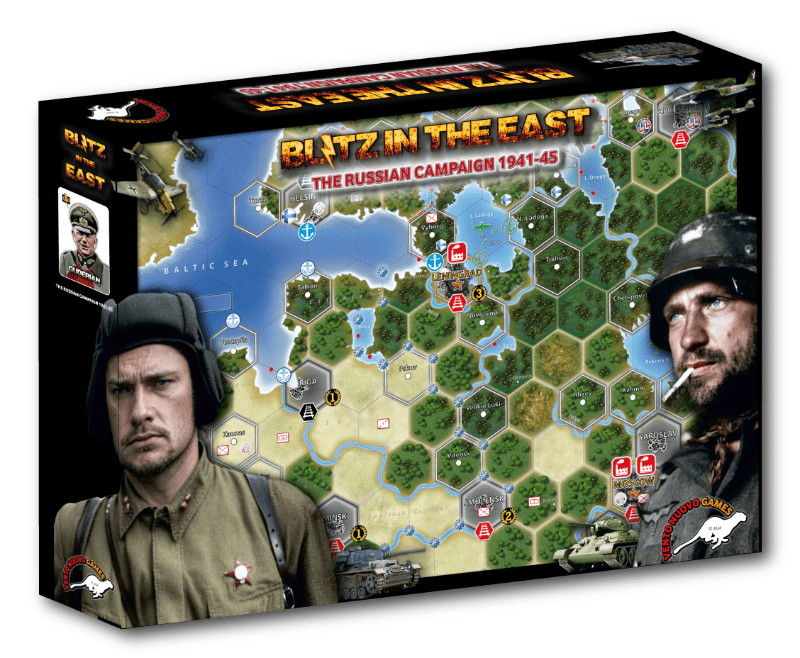
Blitz in the East has moderate complexity and focuses on the ground war. The air rules are simple and concentrate on air support of ground forces. A single map game that is 62x84 centimeters (24.4" x 33.1") in size with large hexes and counters. Low counter density, at least for an eastern front game. Each turn represents 2 months.
A game of BitE has a flow similar to other strategic East Front games. The Axis starts by overrunning the Soviet Union. The Axis must focus on a strategy or it will overextend its army if it goes after too many goals. Armor has massive advantages in open terrain. Snow is the friend of the Soviets and the 1st winter is especially harsh on the Axis. Mud bogs down everyone. If they haven’t lost the war in 1941 or 1942 the Soviets improvements in armor, air, and organization help it turn the tide on the Axis forces. Soviet greatest advantages lie in production and more ground units. BitE uses clever game mechanics to address the advantages of each side.
The Soviet army improves over time via simple mechanics. No need for multiple CRTs or replacing counters or complicated production rules. The beginning Soviet structural weaknesses are: (1) Cadres cannot be promoted to full units, (2) ground units cannot stack, and (3) no Blitz capable units.
The counters are double-sided. The weaker side is the Cadre and the stronger is the Full Strength. Until the proper cards are played the Soviet player cannot build up Cadres to full strength. Cadres are usually slower, more fragile, and weaker than Full Strength units. The worst Soviet infantry unit cadres have only 2 movement points, so they often can’t even move away from advancing Axis forces and can’t infiltrate between Axis ground units even in the best terrain and weather.
It is only after much of the Soviet army is decimated in the first 2 turns that the Soviet player gets to use its superpower, production. The Soviets can resurrect lots of ground units, especially if the Great Patriotic War card is played. The Soviets will hit production limits. Oil is the greatest limiting factor, which limits the production of armor and air units and the ability to launch an attack. But the Axis has even less oil. The discounted price for ground units provided by the Great Patriotic War card expires after 1942 or after Moscow is lost to the Axis.
The Axis also has superiority in armor and air early in the game. Superiority in either provides the player a 1 column shift during the Attrition Phase. The number of air and armor units available was carefully calculated by the designers. For much of the game the Axis can have a maximum of 8 steps compared to Soviet maximum of 5, so killing or scaring away at least one Soviet air is vital. A similar balance exists between Axis and Soviet armor. Once the Soviets can have full strength armor and gain a couple of new armor units, the Axis will loose its strategic armor advantage.
Armor and air also provides advantages in attacks, allowing for shifts in the CRT to the side with either advantage over the other. Though armor superiority for the attacker is canceled by terrain that isn’t open.
Simplified Sequence of Play
I simplified the Sequence of Play (SoP) by consolidating some of the steps to keep this review shorter than the rules book.
The Axis player goes first. Both players have the same SoP. Throughout the rules the players are identified as the Phasing Player and the Non-Phasing Player. Each player gores through phases 1-6 and then the other. A traditional You Go/I Go sequence. The current player is referred to as the Phasing Player.
- Administrative Phase
- Ground Movement Phase
- Attrition Phase
- Attack Phase (depends on purchase of Attack Chit)
- Blitz Phase (depends on purchase of Attack Chit)
- Final Phase
The Attrition Phase is the most unique element of BitE and most action occurs in it. The Attack and Blitz phases only happen if the player can and is willing to buy an Attack Chit for the turn. It is necessary to master the Attrition Phase to win the game.
Administration Phase
During the Administration Phase the Phasing Player draws a card, may play a single Strategic card, checks supply, collect and spends Production Points (PP), places reinforcements, and conducts Strategic Rail, Air, and Operational Movement.
The card drawn might be a Strategic or a Tactical card. Once Strategic cards are played they remain in play until a given condition is met. Strategic cards cover assets and events. Tactical cards are played by the Phasing Player during an attack and are put back in the hand to be played in a future turn. Players can have the cards picked according to historical sequence or use Optional Rule 3 so all the cards for a given year can be mixed up and randomly picked. This option provides variation in play while ensuring that the effects of D-Day doesn’t occur in 1942.
PP come in 2 flavors: Goods and Oil. Goods are based on the number of factories and mines hexes, Oil by number of Oil hexes. PP can be accumulated from one turn to the next. PP can be spent on organizing disorganized units, replenish Cadres to Full units, upgrade units, resurrect destroyed units, and to purchase an Attack Chit.

Goods are required for purchases involving infantry, armor, and air units. Oil is required for Armor and Air units. The attack chit requires 2 goods and oil PP for the Axis and 4 of each for the Soviets if the Soviets played the Great Patriotic War (GPW) card. In exchange the GPW card lowers the cost of ground units by 1 Good in 1941 and 1942. There is an extra cost for replenishing and reorganizing units on the front line. The Production Costs Table shows the normal production costs and the production costs for the Soviets if the GPW card is played.
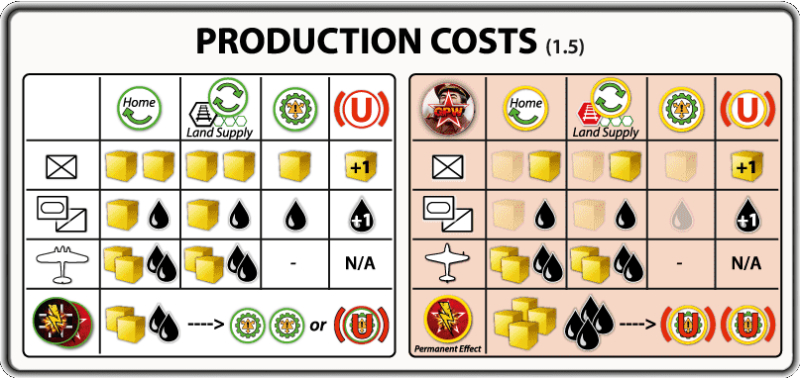
Units must be within 3 friendly hexes of a friendly Railyard hex to replenish or upgrade.
Reinforcements are associated with specific Strategic Cards. Compared to other East Front games there are relatively few reinforcements. There is no cost to playing reinforcements other than playing the associated Strategic Card.
The Phasing Player may move one ground unit by Strategic Movement from one friendly rail station to another. The unit may still move by Operational or Ground Movement.
Operational Movement (OM) is a form of ground movement that allows a ground unit to ignore terrain costs but it must also avoid enemy ZOCs. If a unit moves by OM it may not use Ground Movement (GM) nor participate in combat. It may only move into friendly controlled hexes.
During Air Movement (AM) an air unit may move twice its movement allowance. Air units may only move to friendly controlled cities.
SM, OM, and AM all happen before Ground Movement. No advances into enemy territory occurs.
Movement Phase
In the Movement Phase the Phasing Player moves their units and sets them up for the Attrition and Attack Phases. Movement is similar to most other wargames but with a few twists.
Units are not guaranteed the ability to move 1 hex. If a unit doesn’t have enough MPs to enter an adjacent hex it cannot move. This rule is important because group units pay +1MP to leave a enemy Zone of Control (ZOC) and +2 to move directly from one ZOC to another. So the weakest Soviet infantry cadres with 2 MP cannot exit an Axis ZOC if they are not moving to open terrain in clear weather.
Pay extra attention to ZOCs during movement. They do not extend into enemy controlled urban hexes — even if unoccupied — nor across unfrozen rivers. In the winter rivers freeze and ZOCs suddenly extend across rivers, affecting movement and combat.
Stacking is enforced all of the time except while a unit is moving. Units may not exceed stacking limits at the end of the Movement Phase or any other phase. At the beginning of the game The Axis may stack up to 2 ground units per hex and the Soviets only 1. This gives the Axis a large advantage in both being able to concentrate strength in attacks and flexibility in retreats. The Soviets may start stacking 2 units once they play the Vasilevsky card in 1944.
Attrition Phase
The Attrition Phase simplifies the process of resolving static combat. But it still requires the players to be careful in the placement of their ground units. It is a highly abstract resolution to fighting on static lines. While it can be devastating to the Non-Phasing Player it doesn’t provide for exploitation. It provides most of the combat during BitE.
The Attrition Phase is mandatory. Each side counts up the combat points on the front line, compares the numbers, makes some adjustments, and then looks up the results on the Attrition Table. No dice involved.
Units are counted only if they are Up Front. This is different from ZOCs. Being Up Front means being adjacent to enemy units. So units separated by a river are Up Front even though their ZOCs do not extend across the river. Units in the Fortress Cities of Moscow, Leningrad, and Sevastopol are tripled. All Non-Phasing player units are counted, only in supply and organized Phasing Units are counted.
If a side has Air or Armor superiority they get 1 column or row shift in their favor for each superiority. Compare the number of steps of Air units within range of the front line and the number of armor units on the front line or 1 or 2 hexes away, depending on the year. If a side has a 2:1 advantage they have superiority and get the shift.
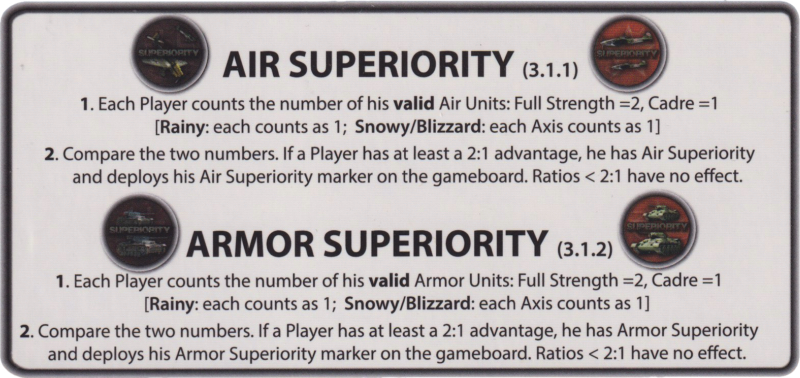
The results for the Phasing player is number of hits they take and the number of Attrition Hexes and Battle Markers they gain. The Non-Phasing player also takes hits and gets a set number of Air Reaction Markers.
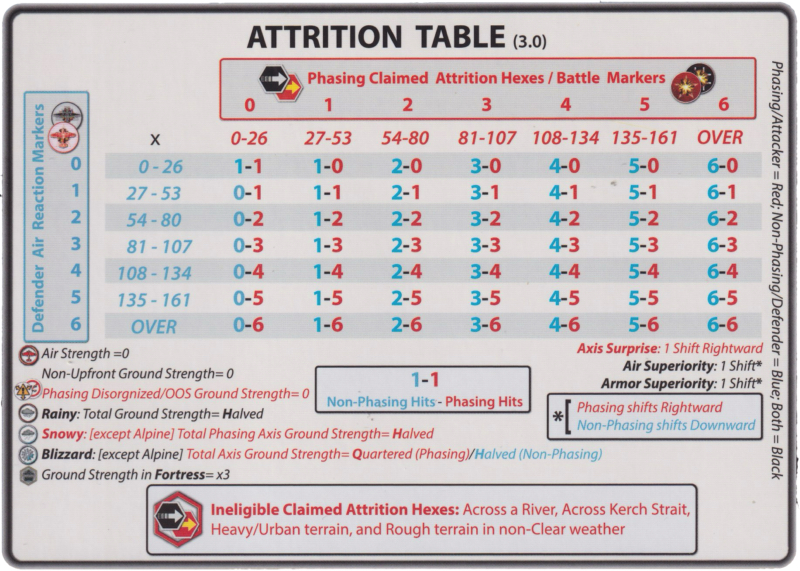
Each player gets to choose which of their own units are damaged, and each unit must receive 1 step of damage before a 2nd hit can be assigned to a unit. Damage is evenly distributed. A Full Strength unit can take up to 4 hits. The first disorganizes it, the second reduces it to an organized Cadre, the 3rd disorganizes the Cadre, and the 4th destroys it. Disorganized units cannot move, retreat, nor attack.
After both sides take loses, the Phasing Player can make up to N enemy Up Front units retreat 1 hex. N is the number of Claimed Attrition Hexes result from the Attrition Table. Urban and Rough hexes and hexes across unfrozen rivers cannot be claimed. Nor can Rough terrain in Rainy or Snowy weather. A Non-Phasing unit retreats from the hex and at least 1 Phasing unit must advance. If a Non-Phasing unit is disorganized or cannot retreat it is destroyed.
Careless placement of units can result in the destruction of Non-Phasing units. If a defending unit is in Open terrain or Rough terrain in good weather, if a takes a loss and becomes disorganized it is vulnerable to being destroyed by being forced to retreat. Since stacking rules are enforced in this phase, the Soviets are very vulnerable to losing units if they have 2 lines of units on defense. The Phasing Player must pay attention to the combat factors on both sides, they might want to not maximize the number of friendly units that are Up Front in order to keep down the number of combat points involved by the defenders.
In one game I played, the Soviets decided with withdraw and have only 2 units in contact with the Axis. This minimized the Soviet losses. However, this meant that one of the units, which which was in Leningrad, would have to take 1 of the 2 hits, making it disorganized and much weaker in defending itself from the Axis the next turn. The Phasing Player must strongly consider how many which units to bring in contact with the enemy.
Attack Phase
The Attack Phase resembles attacking in most other wargames. One or more ground units attack a single enemy unit with optional air support. The defending units defense is its combat strength and is multiplied by 2 or 3 for certain terrains. The odds column may be shifted to the right or the left by air support, armor superiority, pincer bonus, a Tactical card, and an Axis 1 column bonus shift on turn 1. The results are hits for each side, handled in the same manner as in the Attrition Phase, and there is a possibility of mandatory retreat by the Non-Phasing player.The Ground Combat Result Table (GCRT) provides information on all of the conditions that affect calculations.
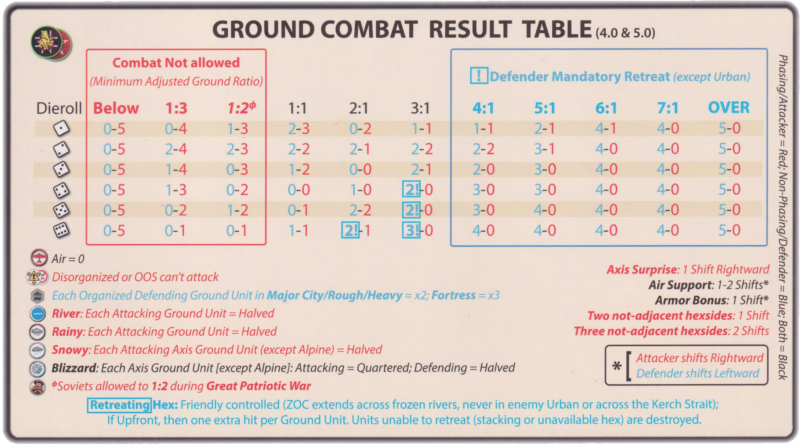
But the Attack Phase is much more limited than in other games. It occurs only if the Phasing Player has purchased an Attack Chit, and the number of attacks is limited to the number of Battle Markers awarded in the Attrition Phase. Attack Chits are expensive and should not be purchased unless attacks are planned. Ground units may only attack if odds are at least 1:1 before modifications.
The results of the ground combat is simple. Each side may take a number of hits which are resolved as in the Attrition Phase. Surviving Non-Phasing Units may voluntarily retreat or may be forced to retreat, Disorganized units are eliminated if forced to retreat. Units in urban hexes never have to retreat.
Prior to a given ground attack aircraft attack each other. An air unit may attack another air unit within range. Or if each side has an air unit supporting ground combat the air units will fight first with surviving units supporting their ground forces. An air unit has a maximum of 2 steps and an air battle will have only 1 air counter per side. Each side rolls one die. There is a hit if the die role is greater than or equal to the die on the counter. This Axis air counter is at Full Strength and will hit a Soviet air unit on a roll of 4 or more.
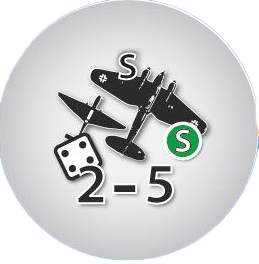
Blitz Phase
The Blitz Phase is minimally like the 2nd movement and combat phase in The Russian Campaign. The Phasing player may do a Blitz Phase only if they purchased the Attack Chit, they have full strength Blitz capable Armor units, and have a Strategic general card(s) that allow a given unit to Blitzing. The Manstein Strategic card is special because it enables any single Panzer army to Blitz.
Blitzing is not limited to the Blitz units. In 1941 an eligible Blitz unit and all adjacent units may Blitz. In 1942 and later it is the Blitz unit and all units within 2 hexes. The Phasing Player needs to plan for a possible hole being punched in the Non-Phasing Player’s line during the Attrition and Attack phases and have the Blitz and accompanying units properly positioned to take advantage of the hole.
Air units may support Blitz attacks if they are adjacent to the Blitz unit in 1941 or within 2 hexes away in 1942 or later. Since Air units may only be based in cities this might not be possible. The Non-Phasing player may react with air support if they have unused Air Restriction Markers.
The Soviets have only 2 Blitz armor units, the Axis 2 plus the Mainstein card. So most units do not participate in a Blitz in any given turn. The Soviets have to wait until 1942 to get the Zhukov card and the accompanying 1st Guard Tank army before they can use the Blitz Phase.
The Blitz Phase can be used in different ways. A Blitzing unit can move and attack twice, going deep into enemy territory. Or a unit can move to join an attack, knowing that during the Blitz Phase that it will be able to return to its original position.
A Phasing player may play a single Tactical card per Blitz Phase if they had not played one in the Attack Phase.
Final Phase
The first of two events is the Final Supply Check. The Phasing Player checks units that were found out of supply in the Administrative Phase. If in supply remove the Out of Supply marker from them. If a unit is still out of supply it suffers 2 hits. If eliminated they are surrendered. Surrendered Axis units are removed from the game. Surrender Soviet units won’t be available for resurrection for a full turn and the Axis gains a Goods and/or Oil point.
The second event is to check if the Phasing Player has achieved victory conditions.
Victory Conditions
The 4 turn Operation Barbarossa scenario has Blitz Victory and Operational Victory conditions. The Axis player should decide which type of victory they will go for before they move their first counter.
Blitz Victory occurs if the Axis captures a specific triplet of cities for that turn and gets a die role equal to or less than the game turn. On Turn 1 the Axis wins if they control Riga, Minsk, and Lvov and roles a 1. On turn 2 the Axis wins if they control Smolensk, Kiev, and Odessa, and rolls a 2 or less. On turn 3 the goal is Leningrad, Tula, and Kharkov and roll a 3 or less. Turn 4 Moscow, Rostov, and Sevastopol and roll a 4 or less. These victory cities are well marked on the map. Capture of these cities also provides the Axis with additional Goods.
Operational Victory is based on the number of points of cities controlled by the Axis by the end of turn 4. The points awarded for each city is printed on the board. So controlling Riga will yield 1 point and controlling Rostov will yield 4 points. The Axis must achieve 21 or more victory points to win, the Soviets must keep the Axis score below 12.
The Russian Campaign scenario covers the entire war. It offers the same Blitz and Operational Victory conditions as Operation Barbarossa, so it is possible to win the game in 1941. Otherwise the game continues until either side wins or turn 28. The Axis wins if they control 3 of the following cities at the end of 1942, 1943, 1944, or 1945: Sevastopol, Moscow, Leningrad, Baku and Stalingrad or if the Axis control 4 of the above cities at the end of any turn. These cities are marked with their nation’s colors or b S1, S2, or G2.
The Soviets win after 1941 by capturing Berlin or earning more than 9 victory points. They earn a Victory Point for each Axis unit eliminated while out of supply and for controlling each of these 9 cities: Kirov, Saratov, Tabriz, Bucharest, Sofia, Helsinki, Bratislava, and Vienna. Note that Kirov and Saratov start in Soviet control and if the Axis controls them they had probably lost the game.
The game is a draw if neither player can achieve their goals.
Cards
BitE is not a card driven game. Rather, the cards are an additional to basic play. The Phasing player picks a card each turn from the stack. In the regular game each card is assigned to a specific turn. Optional Rule 3 has you mix all the cards that are pulled in a given year and then randomly pick a card for that year. The Phasing Player is never required to play a card.
There are Strategic and Tactical cards. The Phasing player may play 1 Strategic card a turn. It gives the player an advantage, but possibly at a cost. Its results might depend on a condition being met, such as Clear weather or occupying specific objectives. The Strategic card might be canceled depending on conditions or the turn. Tactical cards are played by the Attacker during battle. The player may play only 1 card per turn. A Tactical card might have requirements such as weather or terrain. Once played a Tactical card returns to the players hand at the end of the Player turn.
Cards become available on a specified turn unless you are playing with Optional Rule 3. With the optional rule you mix up the cards for a given year and pull them randomly. This does not affect the cards that are initially set up or in the players’ hands at the beginning of the game.

BitE is a Strategic Game
All of these components result in a strategic game. According to BitE designer Emanuele Santandrea, the Axis needs to create its strategy before the first turn. Historically the Axis kept shifting its objectives and couldn’t focus on strategic targets. It is easy for the Axis to demolish the Soviet army in the first 2 turns, but this is not enough to win the game. The Axis player must have a long range plan or the Axis will bog down.
BitE does not force players to follow history. The Axis are free to shift forces to attempt capture Leningrad in 1941 instead of driving for Moscow. The game provides incentives to go after various goals, such as the Axis trying to capture the Caucuses in order to overcome its anemic oil production. The Cards also provide incentives to reach certain goals but they don’t force the players to do anything. Cards may also present strategic choices. For example, the Paulus card ensures that the Axis not lose Guderian and/or Kleist if the Axis failure to occupy Moscow and/or Rostov by the end of 1941, but at the cost of a shorter 1941 offense.
The Axis has to decide if it will attempt to win the game in 1941 by achieving a Blitz or Operational victory or go for a more conservative game and aim for victory in 1942 or 1943.
The Soviets must first concentrate on denying the Axis a victory but then decide when to go on the offensive. Winter, especially the first one, provides the Soviets opportunities for an offensive. But do they have built up the resources to make this practical. In my last game the Soviets went for Finland’s throat in 1943 even though this meant weakening its lines everywhere else in the SU. It paid off big since once Finland was out of the way resources were freed up to fight the Axis in central SU.
Production decisions are strategic because the neither side have enough resources to buy everything that they wants most of the time. Often Organizing units take precedence but the player has to decide what to fix and whether to wait. Since the Axis performs poorly on attack during Snow and Rain turns, that is a good time to rest and store up Goods and Oil unless an opportunity to attack shows itself.
To a limited degree choosing which Strategic cards to play presents strategic choices since only one can be played a turn. For the Germans most of the time they will have a choice of 1 card to play. The Soviets will have to decide whether or not to play the Great Patriotic War card on turn 1, balancing cheaper ground force costs for turns 2-10 against no collection or spending of PP on turn 1 and doubling the cost of an Attack Chit for the entire game. The expansion almost doubles the number of Cards which provides more strategic choices for each player.
Chrome
BitE has little chrome. Most of the chrome is in the 5 optional rules, I recommend playing with Optional Rules 1-4 once you learn the basics. The rules cover minor Axis nations, First Axis Winter, Random Event Card entry, The Leningrad Road of Life, and randomly selecting a side to get a 1 column shift in its favor each turn. The first 4 add realism and also makes life more difficult for the Axis.
Physical Components
The production of BitE is above average. A glossy 32-page color manual. Mounted map/game board. Think counters with rounded corners that can be easily punch out of the counter sheet just like butter. 2 full color player aids. Even the box is very sturdy. My only issues are lack of Table of Contents in the rules, that Heavy terrain could have been more distinct from rough terrain, and that the box wasn’t deep enough to provide enough room for a user provided counter tray. I find a little warping in the mounted board but I didn't notice it while I played the game.
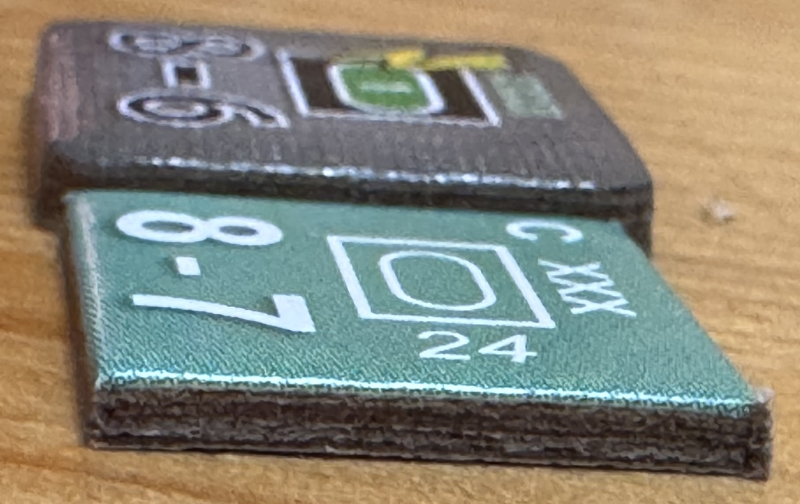
A height comparison between a Blitz in the East counter and a GMT Russian Campaign counter.
I’ve always found VentoNuovo games to include physical components that make it easier to play the games. For example, the Battle and Attrition markers make it easy to keep track of how many are awarded a turn and their use. Turn and Production/Victory Point Trackers are printed on the map. Setup for the 1941 scenario is printed on the map, The Scorched Earth Expansion adds a 1942 scenario.

The Kickstarter edition offered 3 designs of counters: standard NATO counters, icon counters, and Silhouette counters. My taste is for NATO symbols for infantry and icons for armor, but so far I’m quite happy with the NATO symbols. I never had to resort to tracking any information with pen and paper.
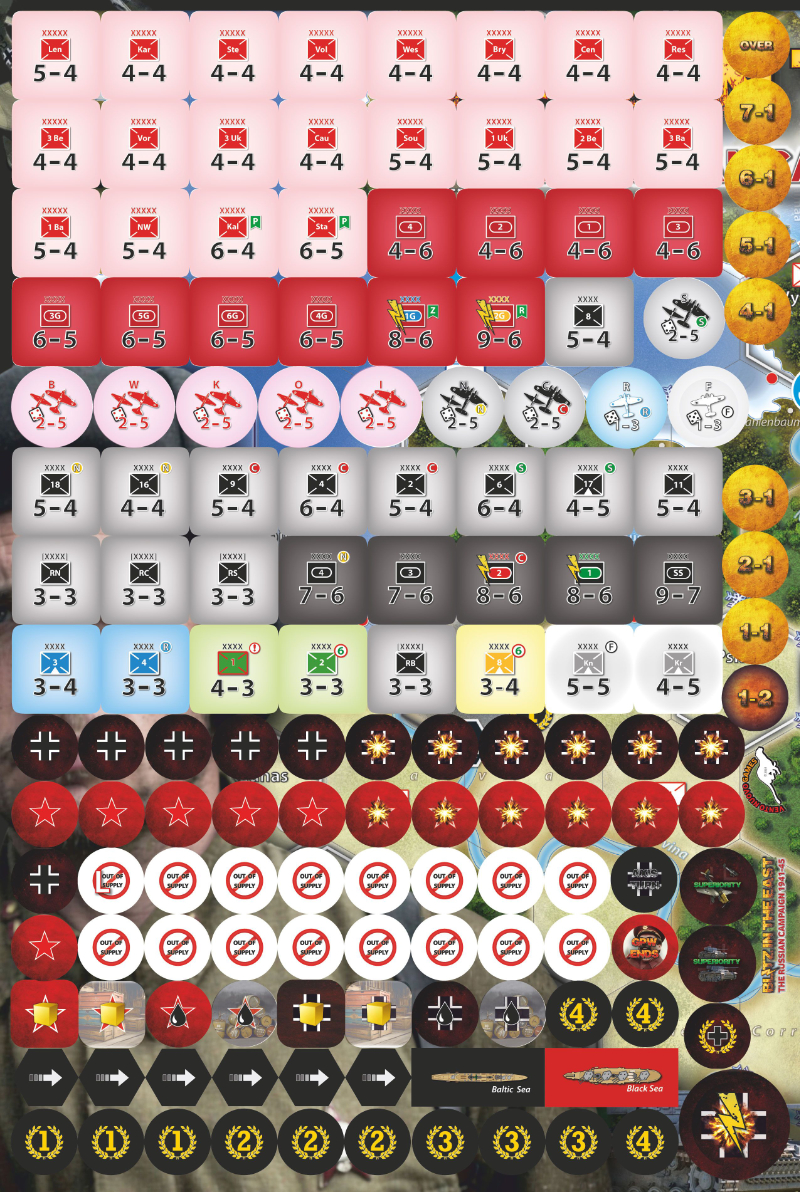
The Ubertex map is a larger roll up map. The hexes are large enough to hold 2 ground units and an air unit without stacking. I find this more pleasant to play but it requires a larger table. The standard map hexes are large enough that players shouldn’t have to resort to tweezers.
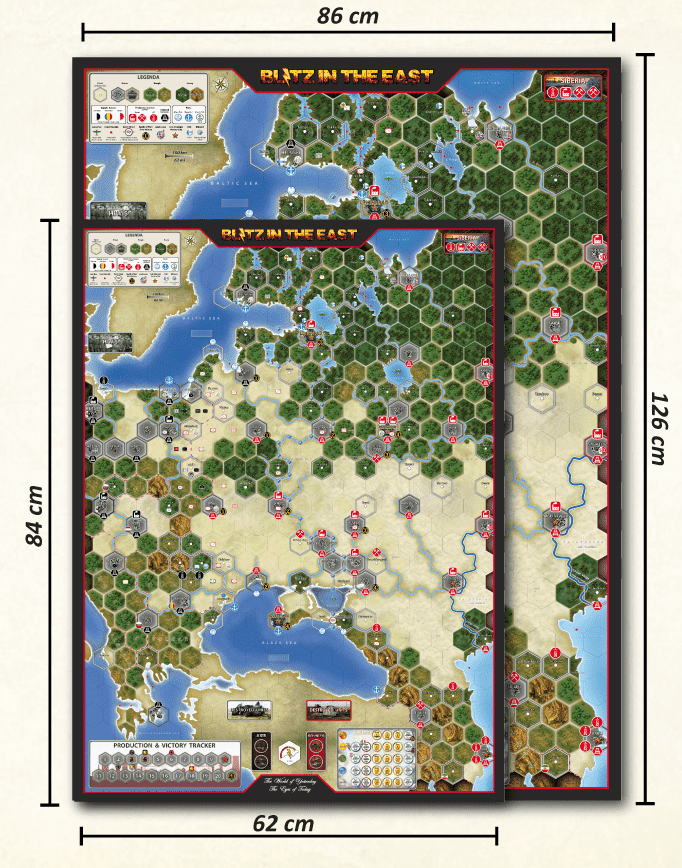
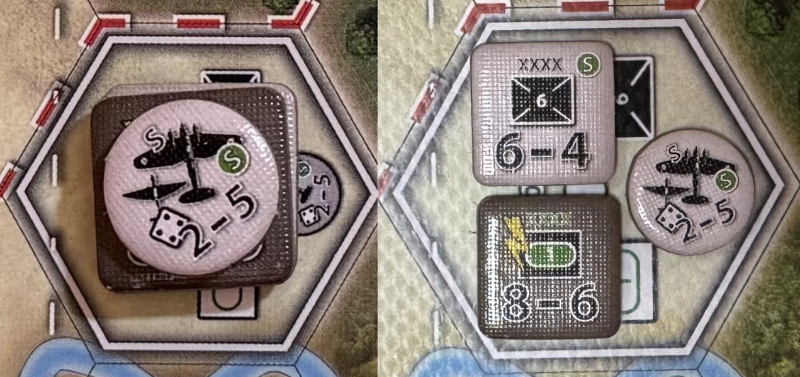
The Scorched Earth Expansion
I will cover The Scorched Earth Expansion in another review. It adds more cards, scenarios, logistics, destruction of resources on capture, movement of Soviet production to Siberia conversion of railyards, and restoring destroyed infrastructure. It requires the use of optional rules 1-4. Most of the new rules are incorporated into the cards. It provides more strategic choices for each player and adds more random events.
Conclusions
BitE is a moderate complexity strategic game of the WW2 Easter front where the complexity of play is greater than the rules indicate.
BitE is a very enjoyable game. It is on the abstract side due to its strategic orientation. It has elements of traditional games, such as counters and hexes and a IGYG turn sequence. But it also introduces new mechanisms such as the Attrition Phase which helps make the game easier to play and simulates the eastern front. If you play the campaign game both sides will experience taking the offensive if the Axis doesn’t defeat the Soviets early in the war.
Emanuele has prepared a Strategy Guide and it will be released once it is proofread. I was provided with an advance copy and it is very useful. It features an historical article by Paul Comben, and excellent description and rules summary, and a review of strategic considerations for each player.
Blitz in the East is published by VentoNuovo Games which is based in Italy.
BitE is available from https://ventonuovo.net/games/blitz-in-the-east for 99 €. MSRP price in US is $128.95. The Ubertex Map MSRP is $128.95. (MSRP pricing from Noble Night Games)
You can also purchase it through Noble Knight in the US (using this affiliate link will tell them I sent you!)
Game Design: Antonio and Emanuele Santandrea
Historical Research and Graphics: Emanuele Santandrea
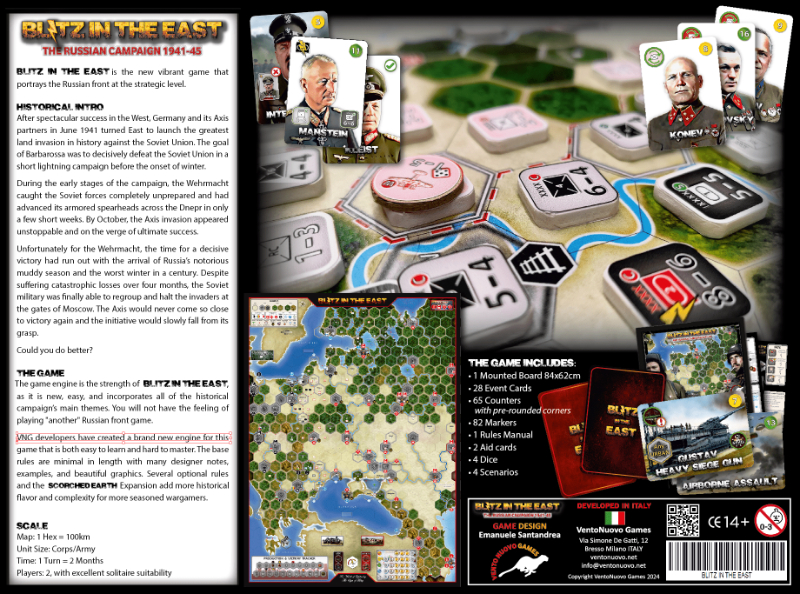
Paul Chernoff has been playing wargames since the year Sinper! was published by SPI. So played games during the golden age of the 1970s with a break through much of the later 1980s, returning in the 2000s. He is doing some rule book design. He can be contacted at



Add comment